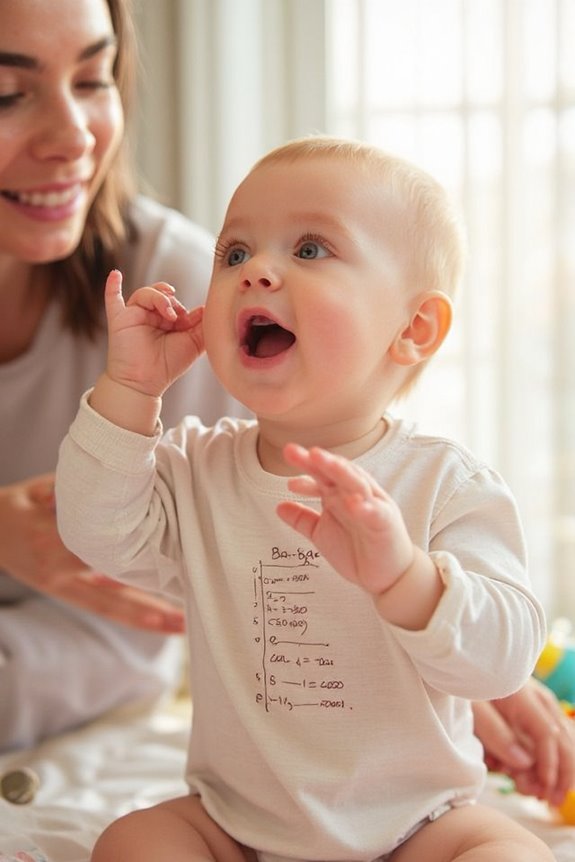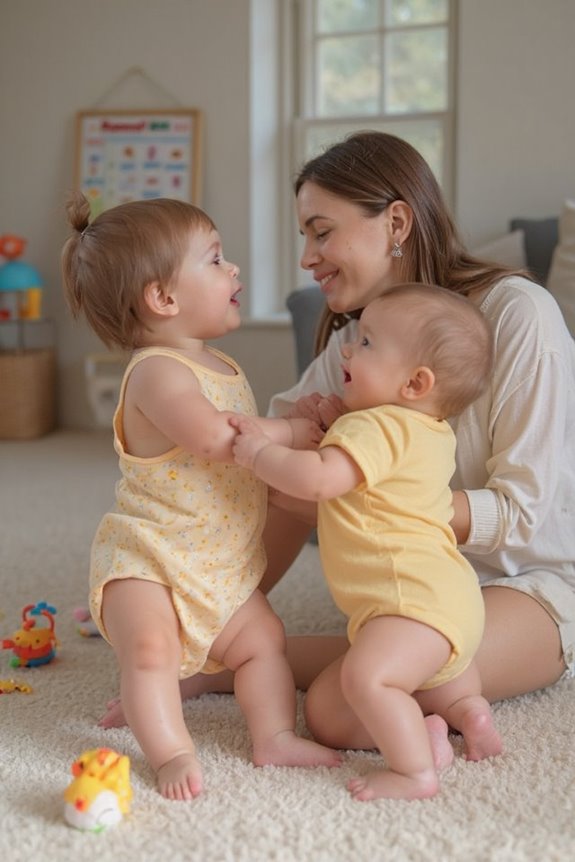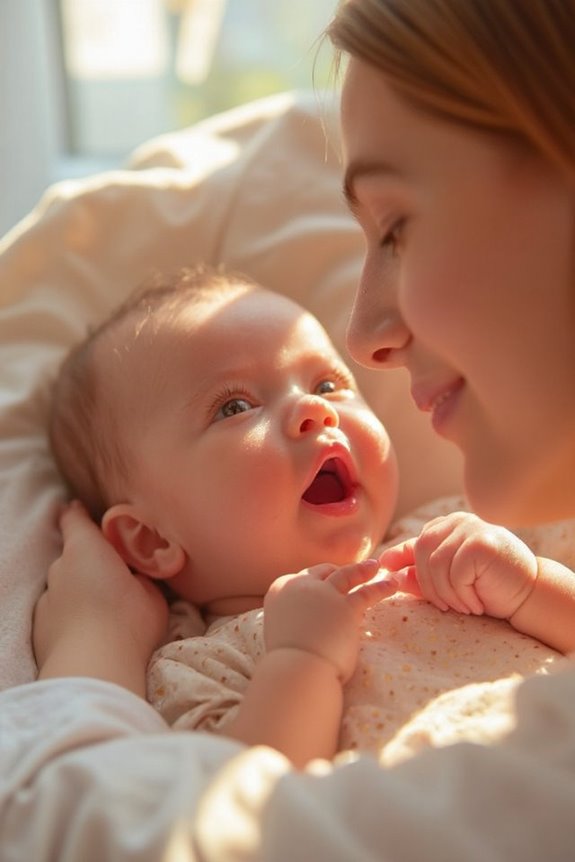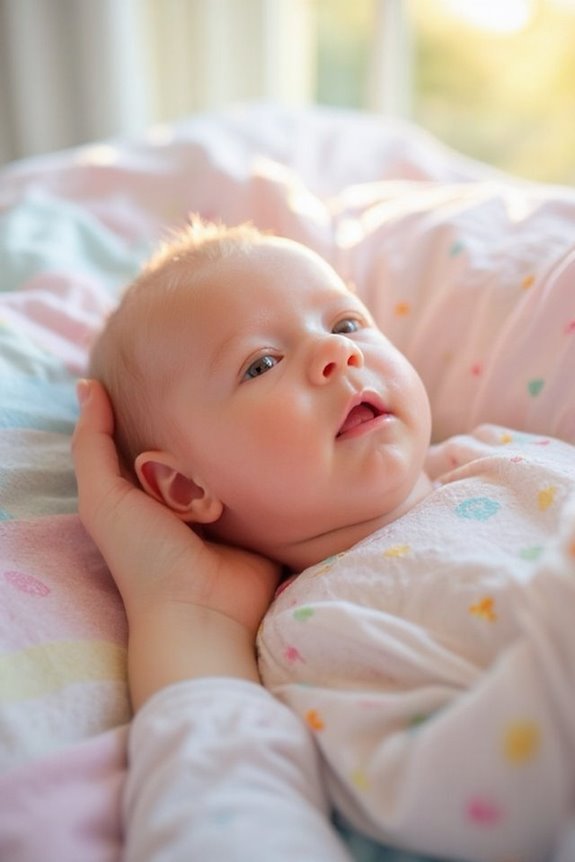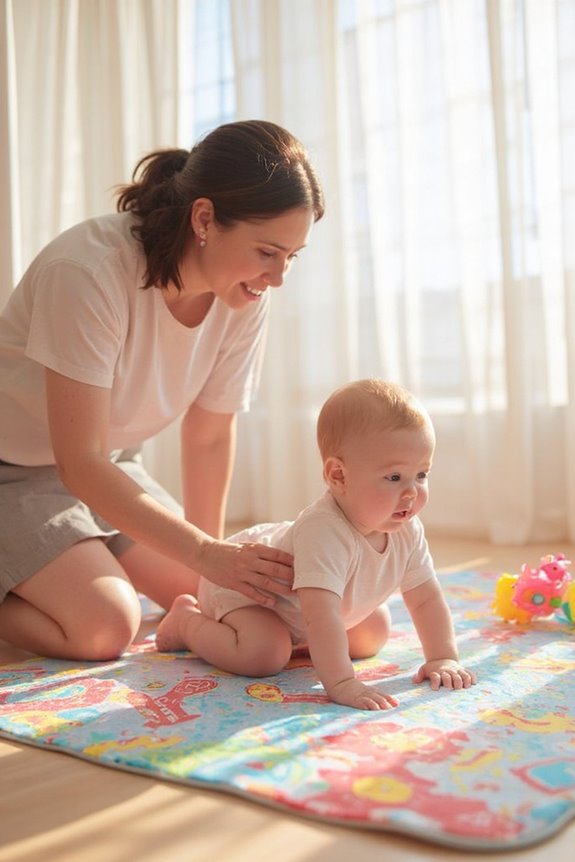Babies typically start babbling between 4-6 months, beginning with simple chain babbling like “gaga.” This follows the cooing stage (0-3 months) where they produce vowel sounds. By 6-10 months, they advance to canonical babbling with repetitive syllables like “bababa.” Each child develops at their own pace, so slight variations are normal. Babbling is essential for language development as it builds the foundation for first words. The progression from simple sounds to complex patterns reveals fascinating developmental milestones ahead.
Key Takeaways
- Babies typically begin cooing with vowel-like sounds around 2 months of age.
- Chain babbling with consonant-vowel combinations like “gaga” emerges between 4-6 months.
- Canonical babbling with more complex sound patterns develops around 6-10 months.
- Reduplicated babbling (repeating identical syllables) occurs at 6-10 months, while variegated babbling begins around 8 months.
- Individual babies develop at their own pace, with babbling progressing from simple to complex sounds throughout the first year.
The Path From Cooing to Babbling: Early Vocal Milestones
As your baby grows, they’ll commence on a fascinating journey of vocal development that begins long before their first words. This path typically starts with cooing sounds around two months of age, characterized by vowel-like “oo” and “ah” utterances.
Cooing serves as the foundation for more complex vocalizations and occurs when babies respond to voices or faces. It’s an essential form of early communication that helps establish connections with caregivers.
Around four months, vocal exploration expands as babies begin incorporating consonants into their repertoire. This shift marks the beginning of babbling, where they’ll combine sounds like “ba” or “ma” into simple syllables.
This progression from cooing to babbling reflects significant neurological development and prepares your baby for future language milestones.
What to Expect: Typical Babbling Timeline by Age
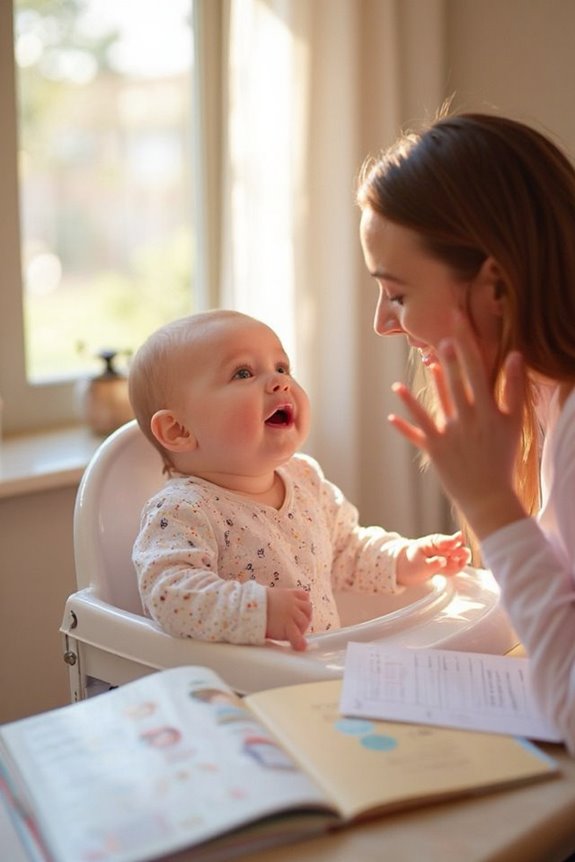
Now that we’ve explored the early vocal developments, let’s look at what parents can expect during their baby’s babbling journey.
Typical Babbling Timeline
- 0-3 months: Your baby begins with cooing and making simple vowel sounds when content
- 4-6 months: Chain babbling emerges with consonant-vowel combinations like “gaga” and early speech sounds begin developing
- 6-10 months: Canonical babbling appears, featuring more complex sound patterns
- 7-12 months: Babies start imitating sounds they hear and using gestures alongside their vocalizations
While this timeline represents typical development, remember that babbling variations are normal. Some babies progress quickly through these stages, while others take more time. Each child develops their communication skills at an individual pace, influenced by factors like hearing ability and social interaction.
Types of Babbling: From Reduplicated to Variegated Sounds
Babies develop their vocal abilities through distinct babbling phases that become increasingly complex over time.
The developmental stages typically follow this progression:
- Reduplicated babbling (6-10 months): Your baby repeats identical syllables like “babababa,” building phonological skills through consistent practice.
- Variegated babbling (around 8 months): As their abilities advance, infants begin mixing different sound combinations such as “ka da by ba mi,” demonstrating more sophisticated vocal control.
These babbling progression milestones are influenced by language exposure in your home environment. Each phase strengthens your child’s infant communication capabilities, preparing them for eventual word formation.
The Importance of Babbling in Language Development

The foundation of your child’s language journey begins with those adorable “ba-ba” and “ma-ma” sounds that might seem random but are actually critical developmental milestones. This babbling significance extends far beyond cute moments for your family videos.
Research shows that babbling serves as a powerful predictor of future language abilities. When your baby babbles, they’re:
- Practicing motor skills needed for speech
- Learning to manipulate different sounds
- Building the phonemic foundation of their native language
- Encouraging social interactions with caregivers
These early vocalizations create important learning opportunities during language acquisition. When you respond to your baby’s babbling, you’re providing valuable feedback that helps them refine their communication skills. Delayed babbling (after 10 months) may indicate potential language disorders, making it an important clinical indicator for professionals.
How Parents Can Encourage and Respond to Babbling
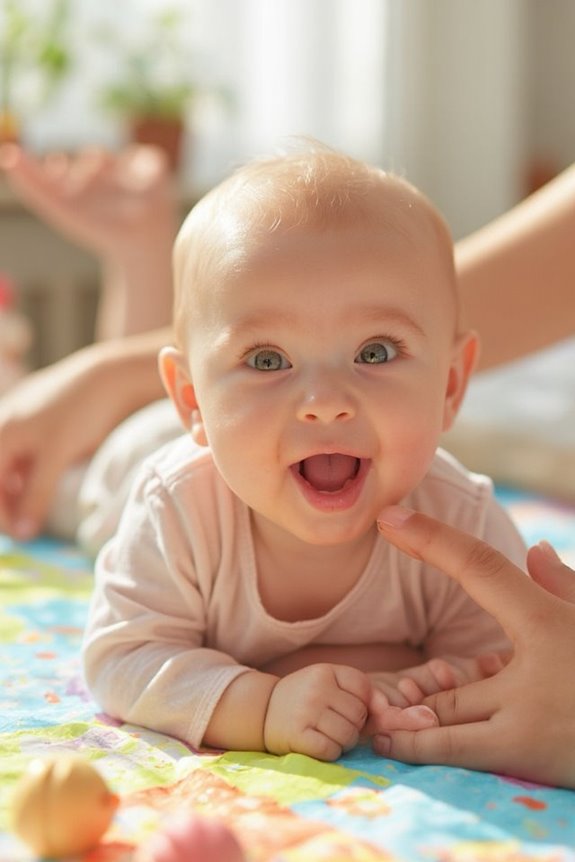
Fostering your baby’s babbling creates a critical foundation for their communication skills. Effective babbling encouragement involves creating a responsive environment where your baby feels their attempts at communication are valued.
- Imitate your baby’s sounds and maintain eye contact to model conversation
- Reduce background noise so they can focus on language
- Introduce vocalization games like taking turns making sounds
- Pause after speaking to give them time to respond
During daily routines, narrate what you’re doing and label objects in your baby’s environment. Responding consistently to their babbling attempts reinforces the connection between sounds and communication. For ideal development:
- Limit screen time in favor of face-to-face interaction
- Use books with repetitive language patterns
- Celebrate all vocal experimentation without correction
When Babbling Transitions Into First Words
As your baby’s brain develops rapidly between 9-12 months, those adorable babbles gradually transform into recognizable words. This change represents a critical phase in your child’s communication development.
Key Babbling Milestones to First Words:
- At 6-7 months: Simple babbling includes consonant-vowel combinations
- 7-12 months: Babbling becomes more complex with varied syllables and imitation
- Around 12 months: First words typically emerge, often naming familiar people or objects
- 18-24 months: Two-word phrases develop from single-word communications
Your responses to your baby’s communication attempts greatly impact this progression. When you acknowledge their babbling with conversation, you’re supporting neural pathways that connect sounds with meaning. The shift isn’t sudden—your baby will mix babbling with first words for several months.
Signs of Healthy Babbling Progress in Babies
Recognizing your baby’s babbling milestones helps you track their communication development from their earliest moments. Healthy babbling shows specific patterns that indicate your child is on the right track:
- Frequency and variety of sounds indicate robust language development
- Vocal exploration with different pitches and volumes shows experimentation
- Imitation skills when your baby copies sounds you make
- Emotional signaling through babbling to express happiness, frustration, or excitement
Frequently Asked Questions
Can Bilingual Households Affect Babbling Patterns or Timing?
Yes, I’ve found that bilingual exposure influences babbling patterns as infants reflect the sounds of both languages they hear. While timing remains around 6 months, their language acquisition shows unique dual-language characteristics quite early.
Do Pacifier Use or Thumb-Sucking Delay Babbling Development?
I’ll tell you—there’s limited research on pacifier effects and thumb sucking impact. While these habits might reduce vocal practice time, occasional use likely won’t delay babbling. Prolonged use, however, could potentially limit sound experimentation.
Is There a Connection Between Babbling and Musical Aptitude?
While 90% of infants babble by 6 months, I’ve found research suggests early babbling development may correlate with musical aptitude. Your baby’s rhythmic experimentation during babbling could benefit from regular musical exposure at home.
Can Hearing Babies and Deaf Babies Have Different Babbling Patterns?
Yes, I’ve seen clear differences in babbling patterns. Hearing babies develop vocal babbling naturally, while deaf babies may have limited vocal patterns but can develop manual babbling when exposed to sign language early.
How Does Babbling Differ Between Twins or Multiple-Birth Siblings?
I’ve noticed twins often develop unique twin communication patterns, including “twin talk” during babbling. Their sibling interactions feature more back-and-forth babbling with each other, though they may experience slightly delayed language development compared to singletons.

